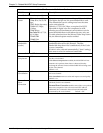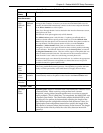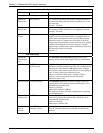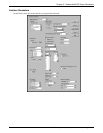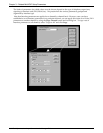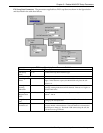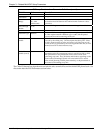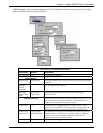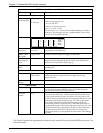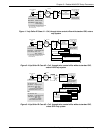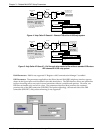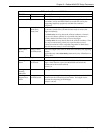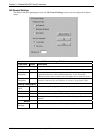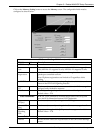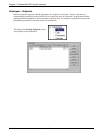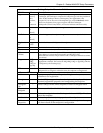
Chapter 3 – Related MultiVOIP Setup Parameters
Multi-Tech Systems, Inc. Avaya Communication Manager Guide 47
FXO Interface: Parameter Definitions (cont’d)
Field Name Values Description
FXO Disconnect On (cont’d)
Disconnect
Tone Sequence
1
st
tone pair
+
2
nd
tone pair
These are DTMF tone pairs.
Values for first tone pair are:
*, #, 0, 1-9, and A-D.
Values for second tone pair are:
none, 0, 1-9, A-D, *, and #.
The tone pairs 1-9, 0, *, and # are the standard DTMF pairs found on
phone sets. The tone pairs A-D are “extended DTMF” tones, which
are used for various PBX functions.
Silence
Detection
One-Way or
Two-Way
Disconnection to be triggered by silence in one direction only or in
both directions simultaneously.
Silence Timer
in seconds
integer value Duration of silence required to trigger disconnection.
Disconnect on
Call Progress
Tone
Y/N Allows call on FXO port to be disconnected when a PBX issues a call-
progress tone denoting that the phone station on the PBX that has
been involved in the call has been hung up.
Ring Count,
FXO
1-99 Number of rings required before the MultiVOIP answers the
incoming call.
Flash Hook Options fields
Generation 50 - 1500
milliseconds
Length of flash hook that will be generated and sent out when the
remote end initiates a flash hook and it is regenerated locally.
Default = 600 ms.
Detection
Range
-- Not applicable to FXO.
Caller ID fields
Caller ID Type Bellcore
The MultiVOIP currently supports only one implementation of Caller
ID. That implementation is Bellcore type 1 with caller ID placed
between the first and second rings of the call.
Caller ID
enable
Y/N
Caller ID information is a description of the remote calling party
received by the called party. The description has three parts: name
of caller, phone number of caller, and time of call. The ‘time-of-call’
portion is always generated by the receiving MultiVOIP unit (on FXS
channel) based on its date and time setup. The forms of the ‘Caller
Name’ and ‘Caller Phone Number’ differ depending on the IP
transmission protocol used (H.323, SIP, or SPP) and upon entries in
the phonebook screens of the remote (CID generating) voip unit. The
CID Name and Number appearing on the phone at the terminating
FXS end will come either from a central office switch (showing a
PSTN phone number), or the phonebook of the remote (CID sending)
voip unit.
The Caller ID feature has dependencies on both the telco central office and the MultiVOIP phone book. See
discussion below.
Low Tones
697Hz
770Hz
852Hz
941Hz
High Tones 1209Hz 1336Hz 1447Hz 1633Hz
DTMF Tone Pairs
1
4
7
*
2
5
8
0
3
6
9
#
A
B
C
D



